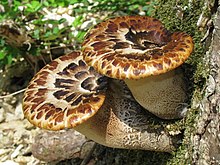
Back دعريات Arabic دعريات ARZ Poliporàcies Catalan Polyporaceae CEB Ăвă кăмпи CV Stielporlingsverwandte German Polyporaceae Spanish Torikulised Estonian Polyporaceae Basque تاقچهایقارچیان Persian
| Polyporaceae | |
|---|---|

| |
| Dryad's saddle (Cerioporus squamosus) | |
| Scientific classification | |
| Domain: | Eukaryota |
| Kingdom: | Fungi |
| Division: | Basidiomycota |
| Class: | Agaricomycetes |
| Order: | Polyporales |
| Family: | Polyporaceae Fr. ex Corda (1839)[1] |
| Type genus | |
| Polyporus | |
| Synonyms[2] | |
| |
The Polyporaceae (/pɔːliːpoʊreɪsiˌaɪ, -siːˌiː/) are a family of poroid fungi belonging to the Basidiomycota. The flesh of their fruit bodies varies from soft (as in the case of the dryad's saddle illustrated) to very tough. Most members of this family have their hymenium (fertile layer) in vertical pores on the underside of the caps, but some of them have gills (e.g. Panus) or gill-like structures (such as Daedaleopsis, whose elongated pores form a corky labyrinth). Many species are brackets, but others have a definite stipe – for example, Polyporus badius.
Most of these fungi have white spore powder but members of the genus Abundisporus have colored spores and produce yellowish spore prints. Cystidia are absent.